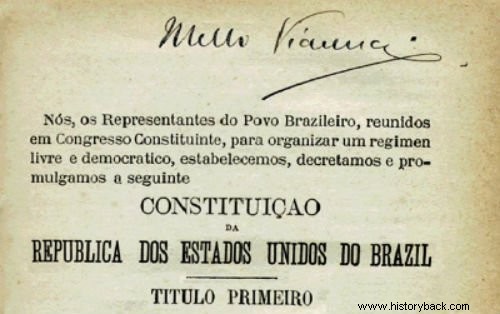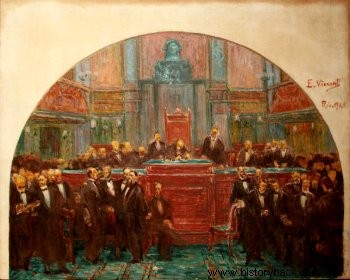The Constitution of 1891 it was the first Constitution of Brazil of the republican era.
Its characteristics were the institution of the presidential republican regime and the separation between the State and the Church.
Historical Context

Preamble of the first republican Constitution of Brazil
Brazil was going through a moment of transition from the monarchical to the republican regime. In this way, the government needed to change the Magna Carta that ruled the country since 1824 and create a Constitution that adjusted to the new reality.
A Legislative Assembly was chosen that drafted the new Constitution in three months. In fact, a large part of the writing was in charge of the jurists Rui Barbosa and Prudente de Morais.
The new Constitution was inspired, among others, by the Constitution of the United States, having as its axis the federalization of the States and the decentralization of power. Even the name of the new country received American influence, as it was called "United States of Brazil".
On February 24, 1891, the new Constitution of Brazil was approved and promulgated. This would be amended in 1926 and revoked four years later because of the 1930 Revolution.
Read more
- Proclamation of the Republic
- American Constitution
- Revolution of 1930
Characteristics of the Constitution of 1891
The Constitution of 1891 determined:
- The creation of three powers:Executive, Legislative and Judiciary, with the Moderating Power extinguished;
- The separation between the State and the Catholic Church. The State would be responsible for issuing certificates and certificates; and Catholic clergy would no longer receive state subsidy;
- Freedom of worship for all religions;
- The guarantee of compulsory, secular and free primary education;
- The ban on the use of coats of arms or noble titles;
- The institution of universal voting for literate Brazilian citizens, over 21 years old;
- The creation of the bicameral Legislative Power. Deputies had a term of three years and senators nine years. This ended the Senate for life;
- The emergence of the provincial Legislative Power. Thus, the provinces could create their own laws and taxes, having more autonomy in relation to the central power.
Summary of the Constitution of 1891

Signing of the Constitution of 1891 , Eliseu Visconti
The 1891 Constitution brought a new political configuration to Brazil.
In addition to the clauses that ended the monarchy, the country would now be configured in another way. There would be more provincial autonomy and the Secular State was created. The Catholic religion was no longer the official religion of the country and all religious denominations could hold public services.
It is important to note that some Church property was confiscated at this time.
Likewise, the change in the vote did not bring great transformations. Voting was open and the citizen had to sign a list that could be easily controlled. With the new criterion – knowing how to read and write – the number of voters fell, instead of increasing.
This Magna Carta was conceived to meet the demands of the São Paulo elite that supported the proclamation of the Republic. These had defended greater decentralization of the State and with this document, they achieved it.
Check here the text of the Constitution of 1891 in PDF.
Read more :
- First Republic
- Old Republic
- Brazilian Constitutions
- Three Powers
